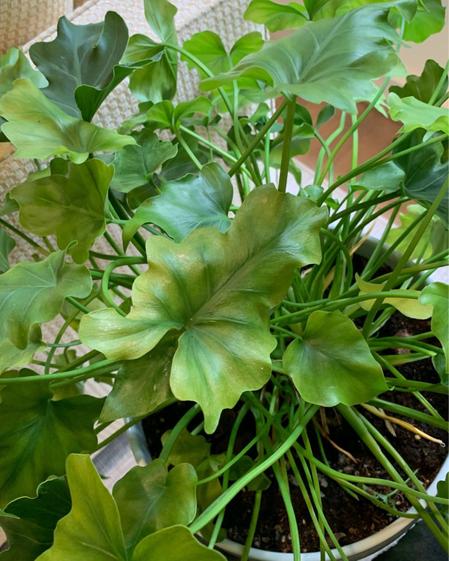Hope Philodendron Care Guide

With its dramatic, deeply lobed leaves and lush, fountain-like growth habit, the Hope Philodendron (Philodendron Selloum) brings a bold, tropical elegance to any indoor space. Unlike vining Philodendrons, this variety grows in a self-heading, upright form—creating a striking presence without the need for a trellis or support. Loved for its sculptural foliage and low-maintenance care needs, the Hope Philodendron is perfect for those seeking beauty and ease in equal measure. Read on to learn how to care for this leafy standout.
Simple Care Instructions for the Hope Philodendron
Light Requirements
Hope Philodendrons thrive in bright, indirect light, but are quite adaptable and can tolerate moderate light conditions as well. While they don’t mind some gentle morning sun, avoid placing them in harsh, direct sunlight, which can scorch their leaves.
If your plant seems to be stretching or losing fullness, it's likely craving more light. Move it closer to a window with filtered light for best growth.
Watering Needs
Hope Philodendrons prefer consistent but moderate watering. Allow the top 1–2 inches of soil to dry out between waterings, and avoid letting the plant sit in soggy soil, as this can quickly lead to root rot.
Typically, watering every 1–2 weeks will keep your plant happy, but adjust depending on the light, temperature, and humidity levels in your home.
Need help knowing when to water? Try using a minimalist moisture meter to remove the guesswork.
Humidity and Temperature
This plant enjoys a bit of humidity and will appreciate occasional misting or being placed near a humidifier, especially in dry winter months. However, it can still tolerate standard indoor humidity fairly well.
Keep your Hope Philodendron in a warm environment between 65–80°F (18–27°C). Avoid placing it near cold drafts or heating vents, which can stress the plant.
Soil and Fertilizing
Use a well-draining, airy potting mix with added perlite or orchid bark. This helps retain some moisture without becoming overly compacted or waterlogged—both of which can lead to root issues.
Feed your plant with a balanced liquid fertilizer once a month during spring and summer. Reduce or skip fertilizing entirely during the fall and winter months, when growth naturally slows down.
Common Problems and Troubleshooting Tips
Yellow Leaves – Overwatering or Lack of Light
Symptoms: Lower leaves turn yellow and may fall off.
Cause: Often caused by overwatering or inadequate light.
Solution: Check if the soil is too wet—let it dry out before watering again and ensure good drainage. If lighting is dim, move the plant to a brighter spot. Trim yellow leaves as needed to maintain a tidy look.
Brown Spots – Fungal Issues or Overwatering
Symptoms: Wet, dark spots on leaves or stems.
Cause: These are often signs of overwatering or high humidity with poor airflow.
Solution: Inspect the soil and roots—if soggy or foul-smelling, repot in fresh soil. Increase airflow around the plant and avoid misting the leaves directly if spotting is frequent.
Leaf Drop – Environmental Stress or Shock
Symptoms: Sudden dropping of healthy-looking leaves.
Cause: Could be due to inconsistent watering, low humidity, or environmental changes such as a move or draft.
Solution: Let the top few inches of soil dry out before watering, and ensure the plant is in a stable, warm, draft-free location. Give recently relocated plants time to adjust.
Leggy Growth – Not Enough Light
Symptoms: Elongated stems and sparse leaf growth.
Cause: Insufficient light causes the plant to stretch in search of more.
Solution: Move the plant to a brighter location with indirect sunlight. Rotate regularly to ensure even growth and consider a grow light if natural light is limited.
Dramatic Wilting – Overwatering or Root Issues
Symptoms: Droopy, limp leaves and soft stems.
Cause: Usually a result of waterlogged soil and poor drainage.
Solution: Remove the plant from its pot, inspect roots, and trim away any that are mushy or brown. Repot in fresh, well-draining soil and adjust your watering routine to allow the soil to dry out more between waterings.

Yellow leaves on a Hope Philodendron, possibly due to watering or over-fertilizing.
Seasonal Care Tips
Your Hope Philodendron will enjoy brighter light in the fall and winter months when the sun is less intense. While it's an adaptable plant, avoid exposing it to direct summer sun, which can cause leaf burn.
During spring and summer, you’ll notice more vigorous growth, and your plant may need water a bit more frequently. You can feed it monthly to support this active phase. In colder months, reduce watering and hold off on fertilizing to avoid stressing the plant while it rests.
With just a little attention to light and water, the Hope Philodendron will continue to reward you with bold, tropical greenery—making it a reliable and beautiful addition to your indoor jungle.





